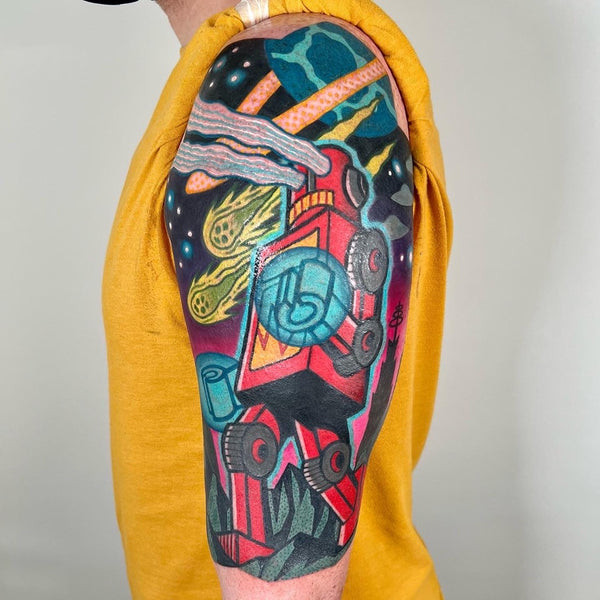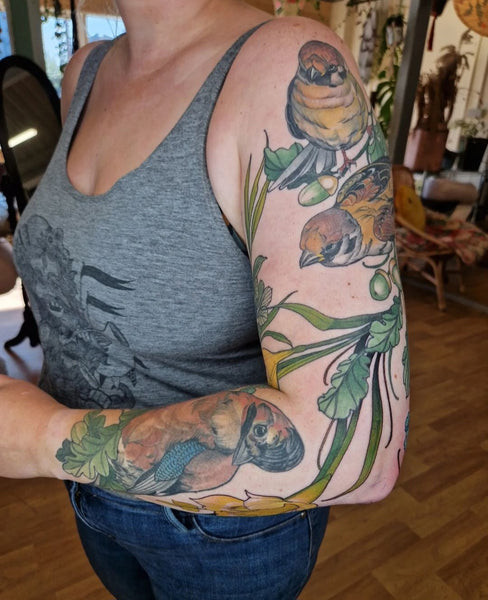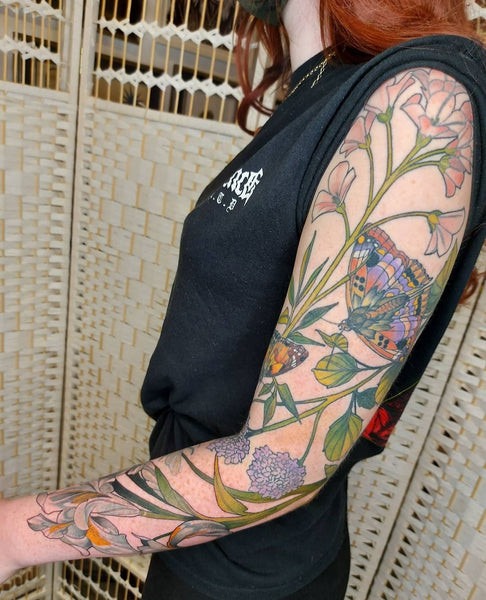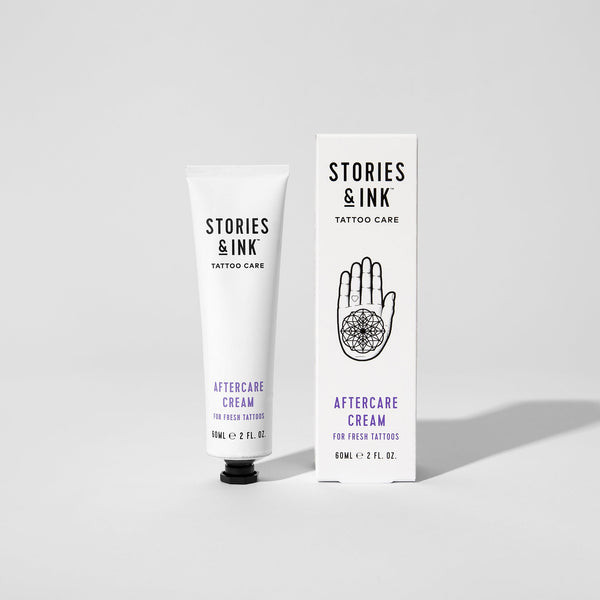What Are Sleeve Tattoos? Sleeve tattoos are extensive designs that cover a large portion of the arm, offering a canvas for storytelling and artistic expression, and if you’re ready to explore the world of arm tattoos, tattooat.com is your ultimate destination for inspiration, artist connections, and expert advice. From full sleeves to half sleeves, various themes, and aftercare tips, understanding sleeve tattoos can help you make an informed decision and create a stunning piece of body art, covering skin, design ideas, and more.
1. What Exactly Are Sleeve Tattoos and Their Variations?
Sleeve tattoos are a popular and striking form of body art that covers a significant portion of the arm. Sleeve tattoos are essentially large, continuous tattoos that can span the entire arm or just a section of it, offering a canvas for intricate designs, storytelling, and artistic expression.
Full Sleeve Tattoo
A full sleeve tattoo extends from the shoulder to the wrist, covering the entire arm in a cohesive design. Full sleeve tattoos provide ample space for elaborate artwork, allowing artists to create detailed scenes, complex patterns, and meaningful narratives that wrap around the arm.
Half Sleeve Tattoo
A half sleeve tattoo covers only half of the arm, typically either from the shoulder to the elbow (upper half sleeve) or from the elbow to the wrist (lower half sleeve). Half sleeve tattoos are a great option for those who want a substantial piece of art but prefer to leave part of their arm exposed or want to start with something less extensive.
Quarter Sleeve Tattoo
A quarter sleeve tattoo covers the upper part of the arm, from the shoulder to halfway to the elbow. Quarter sleeve tattoos are ideal for those seeking a smaller, more discreet design that can easily be covered by clothing.
 Upper arm half sleeve tattoo by Mike Boyd
Upper arm half sleeve tattoo by Mike Boyd
Upper arm half sleeve tattoo by Mike Boyd
2. What Factors Determine the Cost of Sleeve Tattoos?
The cost of sleeve tattoos can vary widely, influenced by several key factors. When considering sleeve tattoos, understanding these elements can help you budget and plan your tattoo journey effectively.
Size and Coverage
The larger the tattoo and the more skin it covers, the more it will cost, reflecting the increased time, ink, and effort required by the artist. Full sleeve tattoos are generally more expensive than half or quarter sleeves due to their extensive coverage.
Design Complexity
Intricate designs with fine details, shading, and color gradients demand more time and skill, increasing the overall cost. Simpler designs with bold lines and less detail may be more affordable.
Artist’s Skill and Experience
Highly skilled and experienced tattoo artists often charge more for their services, reflecting their expertise and reputation, and their proficiency ensures a high-quality tattoo that stands the test of time.
Geographic Location
Tattoo prices can differ based on location, with metropolitan areas or regions with a higher cost of living typically having more expensive rates. Tattoo studios in prime locations or tourist destinations may also charge more.
Number of Sessions
Sleeve tattoos usually require multiple sessions to complete, and each session contributes to the overall cost. The number of sessions depends on the size and complexity of the design, as well as the artist’s working speed.
Color vs. Black and Gray
Color tattoos generally cost more than black and gray tattoos due to the additional cost of colored inks and the extra time needed to apply them. Vibrant, multi-colored designs may require more sessions and touch-ups, further increasing the cost.
Customization
Custom tattoo designs tailored to your preferences may incur additional charges, especially if they require extensive consultation and preliminary sketches. Flash designs or pre-drawn images may be a more budget-friendly option.
3. How Do You Choose a Sleeve Tattoo Theme?
Choosing a sleeve tattoo theme is a crucial step in creating a cohesive and meaningful piece of body art. A well-chosen theme not only ties the individual elements of the sleeve together but also reflects your personal interests, values, and style.
Reflect on Your Interests and Passions
Start by identifying your hobbies, interests, and passions, because the theme should resonate with you on a personal level, making the tattoo more meaningful and enjoyable to wear.
Consider Your Personal Style
Think about your personal aesthetic and the styles of art that you are drawn to, as this could include traditional, Japanese, realism, geometric, or watercolor. The theme should align with your overall style and complement your existing tattoos, if any.
Explore Cultural and Historical Themes
Consider themes rooted in cultural or historical significance, such as Japanese mythology, Norse legends, or ancient civilizations, and be sure to research the symbolism and meaning behind these themes to ensure they resonate with you.
Incorporate Nature and Wildlife
Nature-inspired themes, such as floral arrangements, landscapes, and animal motifs, are timeless and visually appealing, offering a wide range of design possibilities. Choose elements that hold personal significance or represent qualities you admire.
Tell a Story
Use your sleeve tattoo to tell a story or depict a personal journey, and this could involve representing significant events, relationships, or milestones in your life through a series of interconnected images.
Consider the Flow and Composition
Think about how the different elements of your theme will flow together on your arm, and consider the placement, size, and orientation of each image to create a balanced and visually pleasing composition.
 Bird sleeve tattoo
Bird sleeve tattoo
Tattoo by Lucy O’Connell
4. What Are Popular Sleeve Tattoo Design Ideas?
Sleeve tattoos offer a vast canvas for artistic expression, and numerous design ideas can be tailored to individual tastes and preferences. Exploring these popular options can inspire you to create a unique and personalized sleeve tattoo that reflects your style and tells your story.
Japanese Sleeve Tattoos
Japanese sleeve tattoos often feature traditional motifs such as dragons, koi fish, cherry blossoms, and samurai warriors, all rich in symbolism and vibrant colors, and are a great choice if you want a sleeve that tells a story, filled with florals and waves, dragons and smoke.
Traditional Tattoo Sleeves
Traditional tattoo sleeves incorporate classic American tattoo designs like roses, anchors, eagles, and pin-up girls, characterized by bold outlines and vibrant colors. When having traditional tattoo sleeves, you don’t always need a theme, but centering the designs around a couple of ideas creates incredible results.
Patchwork Sleeve Tattoos
Patchwork sleeve tattoos consist of a collection of unrelated images and designs placed together to create a unique and eclectic sleeve, allowing for a diverse range of styles and themes to be incorporated. We love the composition of this patchwork theme. All the elements mesh together with a nature inspired theme.
Viking Tattoo Sleeves
Viking tattoo sleeves draw inspiration from Norse mythology and Viking culture, featuring symbols like runes, Viking ships, and depictions of Norse gods and warriors, ideal for those fascinated by history and mythology. Got a particular piece of history you love? Then dedicate an arm to it like this viking inspired sleeve.
Animal Sleeve Tattoos
Animal sleeve tattoos feature realistic or stylized depictions of animals, each carrying symbolic meanings and representing personal qualities or characteristics, and are always a great theme for a tattoo, from a lion, wolf, or dragon.
Flower Sleeve Tattoos
Flower sleeve tattoos showcase the beauty and symbolism of various flowers, such as roses, lilies, and lotus blossoms, often representing love, beauty, and personal growth. From roses to peonies, fill your arms with beautiful flowers. Whether you choose blackwork or color, flower sleeve tattoos always look beautiful.
Disney Sleeve Tattoos
Disney sleeve tattoos incorporate beloved characters and scenes from Disney movies and animations, perfect for Disney fans wanting to showcase their favorite stories and characters, and are iconic cartoons that look awesome in full color or black and grey.
Marvel Sleeve Tattoos
Marvel sleeve tattoos celebrate iconic superheroes, villains, and storylines from the Marvel universe, appealing to comic book enthusiasts and movie buffs, and are a great way to let everyone know your favorite comics, characters and movies.
5. Why Is It Important to Choose the Right Tattoo Artist?
Choosing the right tattoo artist is crucial for achieving a successful and satisfying sleeve tattoo. The artist’s skill, experience, and artistic style can significantly impact the final result, ensuring a tattoo that not only looks great but also stands the test of time.
Expertise and Skill
Experienced tattoo artists possess the technical skills and knowledge necessary to execute complex sleeve designs with precision and artistry, because they understand how to work with the contours of the body, apply shading and color effectively, and create a tattoo that flows seamlessly.
Hygiene and Safety
Reputable tattoo artists adhere to strict hygiene and safety standards, using sterilized equipment and following proper sanitation protocols, minimizing the risk of infection and ensuring a safe tattooing experience.
Artistic Style
Every tattoo artist has a unique artistic style, specializing in certain types of designs, such as realism, traditional, or watercolor, and choosing an artist whose style aligns with your vision ensures a tattoo that reflects your personal taste and preferences.
Consultation and Communication
The right tattoo artist will take the time to consult with you, understand your ideas, and offer valuable insights and suggestions, collaborating with you to create a custom design that meets your expectations and captures your vision.
Portfolio and Reviews
Reviewing an artist’s portfolio and reading client reviews can provide valuable insights into their skill level, professionalism, and customer satisfaction, and a strong portfolio and positive reviews are indicators of a reliable and talented tattoo artist.
Personal Connection
Establishing a good rapport with your tattoo artist is essential for a comfortable and collaborative tattooing experience, and choosing an artist you trust and feel at ease with will make the process more enjoyable and ensure that you are happy with the final result.
6. Can a Tattoo Artist Help Design and Plan Sleeve Tattoos?
Yes, many tattoo artists can help plan your sleeve with you as part of their booking process, whether you want to give your tattooist a lot of details or give them more free reign.
Collaborative Design Process
Many tattoo artists enjoy collaborating with clients to create custom sleeve designs that reflect their individual preferences and ideas, working with you to develop a concept, sketch out the design, and refine the details until you are completely satisfied.
Expert Advice and Guidance
Tattoo artists can offer valuable advice and guidance on various aspects of sleeve design, including theme selection, image placement, and color choices, and their expertise can help you make informed decisions and create a cohesive and visually appealing sleeve.
Understanding Flow and Composition
Experienced tattoo artists understand how to create a sleeve that flows seamlessly around the arm, taking into account the body’s natural contours and muscle structure, and they can help you choose images and designs that complement each other and create a harmonious composition.
Incorporating Personal Elements
Tattoo artists can help you incorporate personal elements and meaningful symbols into your sleeve design, ensuring that your tattoo tells your unique story and reflects your values, beliefs, and experiences.
Adapting to Your Style
Whether you prefer a traditional, realistic, or abstract style, a skilled tattoo artist can adapt their approach to match your preferences and create a sleeve that aligns with your aesthetic vision.
Creating a Cohesive Sleeve
An artist’s top tip for tattoo collectors is not to get a “taster piece in a space where you’re wanting a larger connected design, as designing a piece to stand on its own is different from designing for a sleeve.” That’s why it’s always worth talking through the structure of potential sleeves with a tattoo artist or planning out what you might get in the future.
 butterfly sleeve tattoo
butterfly sleeve tattoo
Tattoo by Lucy O’Connell
7. What Is the Healing Process Like for Sleeve Tattoos?
The healing process for sleeve tattoos is a critical period that requires diligent care and attention to ensure proper recovery and prevent complications. Understanding what to expect during each stage of the healing process can help you navigate this journey with confidence.
Initial Days
In the first few days after getting your sleeve tattoo, the area will be tender, red, and possibly swollen. The tattoo will also ooze a clear or yellowish fluid, which is normal, and it’s essential to keep the tattoo clean and dry during this time.
First Week
During the first week, the tattoo will begin to form a thin layer of scabs, which is a natural part of the healing process, and it’s crucial to avoid picking or scratching the scabs, as this can lead to infection and scarring.
Second Week
By the second week, the scabs will start to flake off on their own, revealing new skin underneath, and it’s essential to continue moisturizing the tattoo regularly to keep the skin hydrated and promote healing.
Third and Fourth Weeks
In the third and fourth weeks, the tattoo will continue to heal, and the skin may appear slightly shiny or discolored. It’s important to protect the tattoo from sun exposure during this time, as UV rays can damage the ink and slow down the healing process.
Aftercare
Even after the tattoo appears to be fully healed, it’s essential to continue practicing good aftercare habits, such as moisturizing regularly and protecting the tattoo from sun exposure.
Potential Complications
Be aware of potential complications, such as infection or allergic reactions, and seek medical attention if you experience any unusual symptoms, such as excessive redness, swelling, or discharge.
8. How Can You Ensure Proper Sleeve Tattoo Aftercare?
Ensuring proper sleeve tattoo aftercare is essential for promoting healing, preventing infection, and preserving the quality of your new tattoo, and following these aftercare guidelines can help you maintain the vibrancy and integrity of your sleeve tattoo for years to come.
Keep the Tattoo Clean
Gently wash the tattoo with mild, fragrance-free soap and warm water two to three times a day, and avoid using harsh soaps or abrasive sponges, as these can irritate the skin.
Pat Dry
After washing, pat the tattoo dry with a clean, soft towel or paper towel, and avoid rubbing the area, as this can damage the skin and disrupt the healing process.
Apply Aftercare Ointment
Apply a thin layer of tattoo aftercare ointment to the tattoo several times a day, and choose an ointment recommended by your tattoo artist or a reputable brand.
Avoid Sun Exposure
Protect the tattoo from direct sun exposure by wearing loose-fitting clothing or applying a broad-spectrum sunscreen with a high SPF, and prolonged sun exposure can fade the ink and damage the skin, so it’s essential to take precautions.
Stay Hydrated
Drink plenty of water to keep your skin hydrated from the inside out, and hydrated skin is more resilient and heals more effectively.
Avoid Soaking
Avoid soaking the tattoo in water for extended periods of time, such as swimming, taking baths, or using hot tubs, because prolonged soaking can increase the risk of infection and interfere with the healing process.
Wear Loose Clothing
Wear loose-fitting clothing over the tattoo to allow it to breathe and prevent friction, and tight clothing can rub against the tattoo, causing irritation and delaying healing.
Avoid Scratching
Avoid scratching or picking at the tattoo, as this can introduce bacteria and lead to infection and scarring, and if the tattoo itches, gently pat it instead of scratching.

Soothe calm and repair your new sleeve tattoo with Stories & Ink Aftercare Cream.
9. Can You Cover Up an Existing Tattoo with a Sleeve Tattoo?
Yes, if you have an old tattoo you want to cover up, talk to your tattoo artist, because they may be able to create a design that covers the tattoo, or you could choose a black out style sleeve if there are quite a few tattoos you want covered.
Consultation with a Tattoo Artist
The first step in covering up an existing tattoo with a sleeve is to consult with a skilled tattoo artist experienced in cover-up work, who can assess the existing tattoo and determine the best approach for covering it up effectively.
Design Considerations
The design of the cover-up sleeve will need to be larger and bolder than the existing tattoo, using strategic placement and shading to camouflage the old ink, and darker colors and intricate patterns are often used to effectively conceal the previous tattoo.
Multiple Sessions
Cover-up sleeve tattoos may require multiple sessions to complete, depending on the size and complexity of the design, and it’s important to be patient and allow the artist enough time to create a seamless and visually appealing cover-up.
Realistic Expectations
It’s important to have realistic expectations about the results of a cover-up tattoo, and while a skilled artist can create a beautiful and effective cover-up, it may not completely erase the old tattoo.
Laser Tattoo Removal
In some cases, laser tattoo removal may be recommended to lighten the existing tattoo before attempting a cover-up, making it easier to conceal the old ink and achieve a better result.
Consultation and Collaboration
Throughout the cover-up process, it’s important to maintain open communication with your tattoo artist, providing feedback and collaborating on the design to ensure that you are happy with the final result.
10. What Are Some Common Concerns About Sleeve Tattoos?
While sleeve tattoos are a popular and striking form of body art, it’s natural to have some concerns and questions before committing to such a significant piece. Addressing these concerns can help you make an informed decision and ensure a positive tattooing experience.
Pain
Many people worry about the pain associated with getting a sleeve tattoo, especially given the large area it covers, but pain tolerance varies from person to person, and there are strategies to minimize discomfort, such as using numbing creams and taking breaks during the session.
Cost
Sleeve tattoos can be a significant financial investment, given the size and complexity of the design, and it’s important to budget accordingly and choose a reputable artist who offers fair pricing and high-quality work.
Time Commitment
Getting a sleeve tattoo requires a significant time commitment, as multiple sessions are often needed to complete the design, and it’s important to be prepared to dedicate the necessary time and patience to the process.
Regret
Some people worry about regretting their sleeve tattoo in the future, but careful planning, thoughtful design choices, and choosing an artist you trust can help minimize the risk of regret.
Professional Implications
Sleeve tattoos may not be appropriate for all professional settings, and it’s important to consider the potential impact on your career before getting a highly visible tattoo.
Fading and Aging
Tattoos can fade and change over time due to sun exposure, aging, and other factors, and proper aftercare and maintenance can help preserve the vibrancy and clarity of your sleeve tattoo for years to come.
Ready to start your tattoo sleeve journey? Visit tattooat.com for a wealth of design inspiration, a curated list of talented artists, and expert articles to guide you through every step of the process. Discover the perfect design, find a skilled artist, and learn how to care for your tattoo, all in one place. Explore tattooat.com today and bring your vision to life.
Address: 1825 SW Broadway, Portland, OR 97201, United States.
Phone: +1 (503) 725-3000.
Website: tattooat.com.
FAQ About Sleeve Tattoos
What is the difference between a full sleeve and a half sleeve tattoo?
A full sleeve tattoo covers the entire arm from shoulder to wrist, while a half sleeve tattoo covers only the upper or lower half of the arm.
How long does it take to complete a sleeve tattoo?
The time it takes to complete a sleeve tattoo varies depending on the size, complexity, and artist’s speed, but it typically requires multiple sessions spread over several weeks or months.
How much does a sleeve tattoo typically cost?
The cost of a sleeve tattoo can range from $1,000 to $5,000 or more, depending on the artist, location, and design complexity.
What are some popular themes for sleeve tattoos?
Popular themes for sleeve tattoos include Japanese, traditional, nature-inspired, and geometric designs.
Can I design my own sleeve tattoo?
Yes, many tattoo artists are willing to work with clients to create custom sleeve designs that reflect their personal preferences and ideas.
How do I choose the right tattoo artist for my sleeve tattoo?
Look for an artist with experience in creating sleeve tattoos and a style that aligns with your vision, and review their portfolio and read client reviews to assess their skill and professionalism.
What is the aftercare process for a sleeve tattoo?
The aftercare process for a sleeve tattoo involves keeping the area clean and moisturized, avoiding sun exposure, and following any specific instructions provided by your tattoo artist.
Can I cover up an existing tattoo with a sleeve tattoo?
Yes, it is possible to cover up an existing tattoo with a sleeve tattoo, but the design will need to be larger and bolder than the old ink.
What should I do if my sleeve tattoo gets infected?
If your sleeve tattoo shows signs of infection, such as excessive redness, swelling, or discharge, seek medical attention immediately.
How can I make my sleeve tattoo last longer?
Protect your sleeve tattoo from sun exposure, keep your skin hydrated, and follow a consistent aftercare routine to help preserve its vibrancy and clarity over time.
